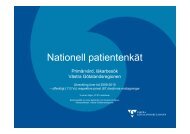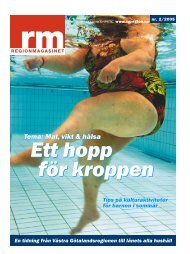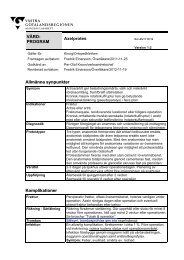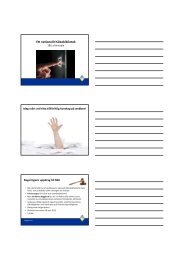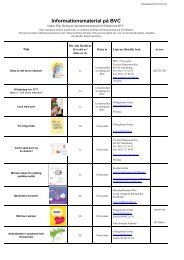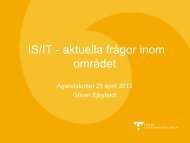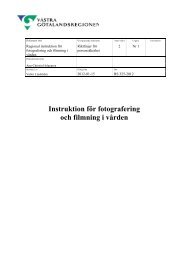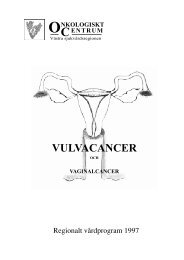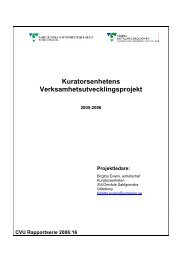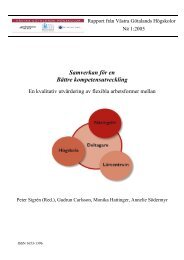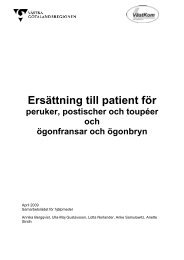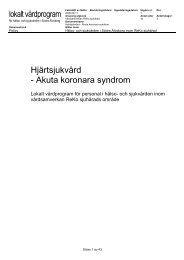FOURTEENTH ANNUAL EUROPEAN PRESSURE ULCER ...
FOURTEENTH ANNUAL EUROPEAN PRESSURE ULCER ...
FOURTEENTH ANNUAL EUROPEAN PRESSURE ULCER ...
You also want an ePaper? Increase the reach of your titles
YUMPU automatically turns print PDFs into web optimized ePapers that Google loves.
Thursday September 1st<br />
Proceedings of the 14th Annual European Pressure Ulcer Meeting<br />
Oporto, Portugal<br />
Heel Pressure Ulcers: a study of wound healing<br />
Elizabeth McGinnis<br />
Leeds Teaching Hospitals NHS Trust, England. Elizabeth.mcginnis@leedsth.nhs.uk<br />
Introduction<br />
Pressure ulcers result in suffering and morbidity to<br />
patients and are costly to the healthcare provider.<br />
Heels are a common location for pressure ulcers<br />
(PUs) [1]. Heel PUs are considered separate entities<br />
to other body sites as the physiology of the heel is very<br />
different: the epidermis is thicker, the dermis has no<br />
sebaceous glands and contains fatty pockets within<br />
the fascia; they are more prone to arterial disease,<br />
neuropathy and oedema. Interventions for healing all<br />
PUs include offloading the pressure, wound treatments<br />
and correcting intrinsic factors e.g. nutritional deficits.<br />
A systematic review of the evidence for effectiveness<br />
of support surfaces for offloading the pressure did not<br />
show efficacy of any specific type of support surface<br />
[2]. No studies have been identified which provide<br />
sufficient evidence for other healing interventions. This<br />
study aims to identify prognostic factors for healing<br />
heel PUs and offer insights that will inform future<br />
intervention studies.<br />
Methods<br />
A prospective cohort study was performed. Patients<br />
with heel PUs ≥ Category 2 were recruited from an<br />
acute hospital, in specific inpatients areas where heel<br />
ulcers were known to occur. Patients were followed up<br />
weekly while in hospital then monthly following<br />
discharge until healing or 18 months. Data was<br />
collected on factors thought to be prognostic for<br />
healing and included demographics, intrinsic factors,<br />
patient and ulcer characteristics, treatments both<br />
systemic and ulcer specific. Analysis was based on<br />
time to healing of each ulcer, this was performed using<br />
Cox proportional hazards (PH) models [3] with robust<br />
standard errors (SE) to allow for clustering.<br />
Results<br />
140 patients with 183 PUs were recruited. 77 (42%)<br />
ulcers healed, 88 (48%) did not heal as the patients<br />
died, 5 (3%) were on limbs which were amputated, 11<br />
(6%) had not healed after 18 months and 2 (1%) were<br />
lost to follow-up. Univariate analysis using a Cox<br />
proportional hazards model identified 12 variables<br />
which reached significance at the p≤0.2 level. Eight<br />
variables were entered into a multivariate model of<br />
which two emerged that reached significance at the<br />
p≤0.1 level: severity of the ulcer and the presence of<br />
peripheral vascular disease.<br />
Discussion<br />
This study is the first known of its kind.<br />
82<br />
More than half of the ulcers did not progress to healing<br />
as a consequence of the death of the patient.<br />
Several factors emerged from the univariate model<br />
which affected the probability of healing but not all of<br />
these reached the p≥0.2 level of significance, these<br />
could have occurred by chance or were due to the<br />
small sample size.<br />
This cohort consisted of a specific patient population<br />
where heel PU were known to occur, results may not<br />
be generalisable to other hospital populations however<br />
as two thirds of the data collection occurred in the<br />
community it seems reasonable to apply cautionary<br />
generalisability to this care setting too.<br />
Data on recruitment rates, duration and outcomes from<br />
this study can be used inform future intervention<br />
studies.<br />
Clinical relevance<br />
As severe pressure ulcers are likely to take longer to<br />
heal than superficial ulcers thus long term care plans<br />
should reflect their needs for ongoing ulcer<br />
management. The presence of PVD is also likely to<br />
delay healing; all heel pressure ulcer patients should<br />
have their peripheral arterial status established to<br />
inform ongoing ulcer management.<br />
Acknowledgements<br />
This study was supported by a Charitable Trustees<br />
Fellowship from LTHT and a Smith & Nephew/ Multiple<br />
Sclerosis Society Studentship<br />
Academic supervisors: Prof EA Nelson, Prof JE Nixon,<br />
Dr D Greenwood<br />
Conflict of Interest<br />
None.<br />
References<br />
[1] Dealey C. The size of the pressure ulcer problem in<br />
a teaching hospital. Journal of Advanced Nursing 16:<br />
633-70, 1991<br />
[2] McGinnis E. Support surfaces for healing pressure<br />
ulcers: A Cochrane Systematic Review. Proceedings<br />
of the 12 th Annual European Pressure Ulcer Advisory<br />
Panel Meeting. Amsterdam, Holland. 2009<br />
[3] Cox DR. Regression models and life tables (with<br />
discussion). Journal of the Royal Statistical Society.<br />
Series B 34:187-220, 1972<br />
Copyright © 2011 by EPUAP



